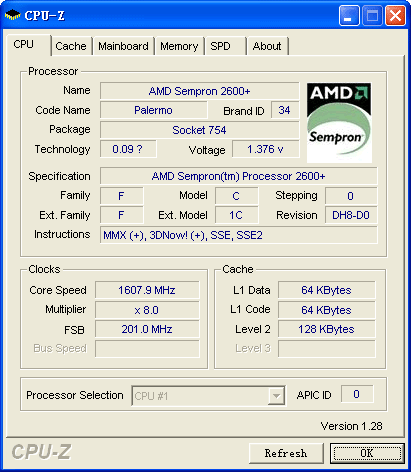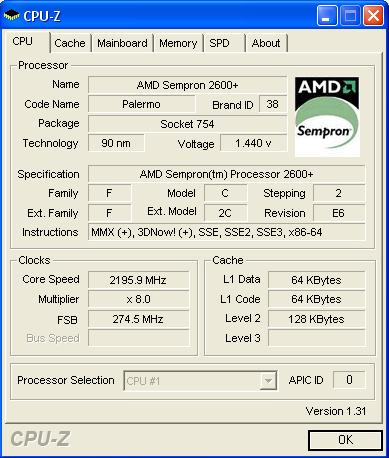AMD K8 Overclocking Guide |
|
Introduction
Overclocking, the practice of pushing your hardware to the limits is a widely practiced ritual by computer enthusiasts for as long as it has been possible to. Today, you can overclock the CPU, RAM and video card with ease. But if you don’t know what you’re doing, you can damage your precious hardware permanently. This guide's purpose is to get you familiar with overclocking on the AMD K8 platform, its basics, and even some advanced topics.The AMD K8 Series
The AMD K8 series is well known for its overclocking capabilities. The K8 series includes all Socket 754 and 939 CPUs. There are many factors that make a CPU a good overclocker.First we have the core. The core is the technology codename of your CPU. There are numerous cores for the K8 series. For Socket 754 we have Clawhammer and Newcastle for the Athlon 64, and the Paris and Palermo for Semprons. For Socket 939, we have the Clawhammer, Newcastle, Winchester, Venice, San Diego, Manchester and Toledo. This may seem like many, but there are very few differences between the cores.
Some are major, while others are less so. The difference between Sockets 754 and 939 is dual channel memory support. In real world applications the difference is about 4-6%, but you should always get the newest platform, in this case, Socket 939.
One major difference between cores is the process size and heat output. The process is measured in nanometers. The K8 series comes in 130nm and 90nm CPU flavors. The major differences are heat output and overclocking potential. The 130nm cores didn’t overclock much, with an average max of about 2.5-2.6GHz using air/water cooling. They also put out significantly more heat. The 90nm cores can reach up to 3.0GHz with low voltages on air/water. The 90nm cores also default at 0.1V less, taking up to 10 degrees Celsius off of the maximum temperature. 130nm cores are no longer produced for the Socket 939 platform, so you don’t have to worry too much.
There is no current reason to buy a Socket 754 platform unless you buy a budget Sempron, which are all 90nm. Overclocking is not guaranteed. Some CPUs overclock great, while the next one of the same model, doesn’t overclock at all. These are extremes, so in general, most CPUs of the same Core overclock to the same maxes.
Let’s examine the differences between the current cores. They are all 90nm. A complete list of all modern CPUs together with their specs can be found in our CPU Database.
| Core | Socket | L2 Cache | Single/Dual Core |
|---|---|---|---|
| Palermo | 754 | 128kb-256kb | Single |
| Venice | 939 | 512kb | Single |
| San Diego | 939 | 1024kb | Single |
| Manchester | 939 | 512kb x2 | Dual |
| Toledo | 939 | 1024kb x2 | Dual |
As you can see, the 939 CPU cores can be paired together. They only differ in cache size.
It's All About Numbers

Now let’s get into the speed numbers behind the K8 series. Let’s use my Sempron 2600+ as an example.
Its stock speed is 1600MHz. How do they get this frequency? There are two factors that multiply to form 1600MHz. The first is the Frontside Bus (FSB). This is 200MHz for all K8 CPUs, regardless of the core. The second is the CPU Multiplier. For this CPU it is a maximum of 8x. This results in 200MHz x 8=1600MHz. for a 2000MHz CPU, the multiplier would be 10x. The multiplier can not be raised, only lowered. The CPU Multiplier on the K8 series CPUs can be lowered to 4x (though there is no need for that). The only exceptions to this rule are the FX series. Their multipliers are “unlocked” and can be changed in both directions. However things get a bit more complicated.
There is also a HyperTransport (HT) speed. This is calculated by multiplying the FSB by the HT multiplier. The HT Multiplier is a maximum of 5x for Socket 939 CPUs, and 4x for 754 CPUs. So the default HT Frequency for 939 CPUs is 1GHz, and for 754 CPUs it is 800MHz. The significance of this I’ll discuss later. Unfortunately this gets even more complicated. The next part to get involved in this overclocking mess is the RAM. By default, the RAM speed is in sync (parallel) with the FSB. PC3200 or DDR400 memory is the default memory speed rating for the K8 series. This same memory runs at 200MHz (400MHz effective). This is the in sync, 1:1 ratio.

Mar 19th, 2025 15:29 EDT
change timezone
Latest GPU Drivers
New Forum Posts
- HalfLife2 RTX Demo Is out! (147)
- Old Gamer Memory Upgrade Worth It? (9)
- Bricked Vega 56 (BIOS Flash) (46)
- possible a770 16gb on the horizon-what do I need to know? (1)
- 5900X Curve Optimizer (Ryzen Master vs. BIOS) and findings? (0)
- AMD RX 9070 XT & RX 9070 non-XT thread (OC, undervolt, benchmarks, ...) (48)
- TPU's Nostalgic Hardware Club (20105)
- What are you playing? (23211)
- Xeon Owners Club (8872)
- Do you know a good call recorder app for android ? (50)
Popular Reviews
- ASRock Radeon RX 9070 XT Taichi OC Review - Excellent Cooling
- Corsair SF750 750 W Review
- Sapphire Radeon RX 9070 XT Nitro+ Review - Beating NVIDIA
- AMD Ryzen 9 9950X3D Review - Great for Gaming and Productivity
- MSI GeForce RTX 5070 Gaming Trio OC Review
- XFX Radeon RX 9070 XT Mercury OC Magnetic Air Review
- Kioxia Exceria Plus G4 2 TB Review - Energy-Efficient PCIe Gen 5
- ASUS Radeon RX 9070 TUF OC Review
- ASUS GeForce RTX 5090 TUF Review
- AMD Ryzen 7 9800X3D Review - The Best Gaming Processor
Controversial News Posts
- NVIDIA GeForce RTX 50 Cards Spotted with Missing ROPs, NVIDIA Confirms the Issue, Multiple Vendors Affected (519)
- AMD RDNA 4 and Radeon RX 9070 Series Unveiled: $549 & $599 (260)
- AMD Mentions Sub-$700 Pricing for Radeon RX 9070 GPU Series, Looks Like NV Minus $50 Again (250)
- NVIDIA Investigates GeForce RTX 50 Series "Blackwell" Black Screen and BSOD Issues (244)
- AMD Radeon RX 9070 and 9070 XT Official Performance Metrics Leaked, +42% 4K Performance Over Radeon RX 7900 GRE (195)
- AMD Radeon RX 9070-series Pricing Leaks Courtesy of MicroCenter (158)
- MSI Doesn't Plan Radeon RX 9000 Series GPUs, Skips AMD RDNA 4 Generation Entirely (140)
- Microsoft Introduces Copilot for Gaming (123)